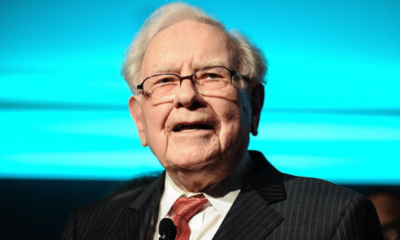Success Advice
Why Carlos Slim Is The Richest Man In The World

Read on to see how the worlds richest man has come to be.
Carlos Slim is currently the world’s richest man. Carlos has been an entrepreneur since the age of 12, when he first decided to purchase shares in a Mexican bank. Now Carlos Slim is worth billions upon billions ($75.5 Billion to be exact).
Carlos Slim – The World’s Richest Man
Carlos Slim Helu’s father, Julian, was a Lebanese immigrant to Mexico where he operated a dry goods store and invested in commercial real estate in Mexico City, which made him wealthy.
Julian seemed to have been aware that Carlos was going to be good at commerce and would educate him on business dealings. Although he was only 12 years old when his father died, Carlos inherited his fathers business talents, whose work ethic and business acumen was extraordinary.
Carlos first worked at the family company before studying civil engineering and eventually becoming a stock broker in his own brokerage firm. He invested wisely in a variety of businesses so that by the time he was 26 he was already worth forty million dollars. However, Carlos never wanted to be a stock trader, preferring to be a good businessman. Carlos Slim’s mastery of numbers is legendary. In the 1960s, his studies of linear programming gave him a formidable edge in the business world. Using this amazing talent, In 1981, Carlos did his homework and decided to buy into the second largest tobacco company in Mexico, Cigatam, who made Marlboro cigarettes. With the money he made, he was able to begin buying companies.
As oil prices declined in 1982, the Mexican economy started to go downhill . That’s when Carlos wisely invested the Cigatam profits in the Mexican divisions of American businesses such as Reynolds Aluminum and Hershey Corporation, as well as Mexican financial services. Basically, Carlos Slim earned his fortune and his power by putting monopolies together, especially in communications. He is a ruthless businessman, buying companies cheaply, organizing them and quickly driving competition out of business. Gathering many businesses with interests in construction, mining, printing, tobacco, food, and retail, he formed a conglomerate.
In the late Eighties Carlos Slim added other companies that traded in copper, aluminum and chemicals, after which he sold shares in his conglomerate, Grupo Carso, as a public company. He also bought Telmex, the telecommunications company. Along with Telcel, his mobile phone company, they handle most of Mexico’s phone and mobile lines.
In the Nineties, after buying the Mexican division of Sears Roebuck, Carlos began expanding his business empire out of Latin America by setting up Telmex USA and by joining Microsoft to begin a portal called ProdigyMSN.
One of the few business mistakes Carlos made was buying a stake in CompUSA in 1999 for $800 million. Unfortunately, the sales of personal computers were slowing down at the time because they were more and more obsolete as new technology became available. Carlos tried everything to keep them afloat, including changing CEO’s and other various strategies, but eventually the chain closed more than half its stores and sold the rest.
Carlos says that he has lost count of the “more than two hundred companies” he now controls. If he dines out in a restaurant, chances are that he owns it. Believe it or not, he does not even use a computer himself, preferring the old skool way, “a pen and paper!”
Carlos Slim has a mansion in Mexico City where he has hosted American presidents and famous Mexican novelists. He claims to live a rather rustic life, not traveling much and enjoying baseball as he roots for the New York Yankees. Rather, he enjoys staying at home and reading about the military strategies of Genghis Khan.
Although Carlos Slim is the largest private employer in Mexico and the world’s richest man, he is thrifty and not at all flamboyant as many businessmen of his social status tend to become. Described by his business associates and competitors as being very aggressive, he is a power to be reckoned with. That power extends to the Mexican legislature. His lawyers have successfully blocked any legislation that threatens his companies.
Carlos Slim’s 10 Keys To Business Success
1. Have a simple organizational structure
2. Maintain austerity
3. Focus on growth
4. Minimize non-productive things
5. Work together
6. Reinvest profits
7. Be charitable
8. Keep optimistic
9. Work hard
10. Create wealth
In one of his latest newspaper interviews, Mr. Slim states that he believes the retirement age should be expanded to 70 years old since originally the retirement age was based more on physical work but now it should be based on services provided rather than hard physical labor.
Having had a heart attack in the late Nineties, Carlos has slowed things down, allowing his six children and their spouses to take more responsibility, although he remains “Honorary Lifetime Chairman” of his businesses.
Focusing now on Mexican and Latin American education, health and employment, Carlos is Chairman of five Boards involving this work.
Carlos Slim’s Net Worth is now $75.5 billion dollars, making him the world’s richest man.
Carlos Slim Quotes
“All times are good time for those who know how to work and have the tools to do so.” – Carlos Slim
“Do not allow negative feelings and emotions to control your mind. Emotional harm does not come from others; it is conceived and developed within ourselves.” – Carlos Slim
“Live the present intensely and fully, do not let the past be a burden, and let the future be an incentive. Each person forges his or her own destiny.” – Carlos Slim
“When there is a crisis, that’s when some are interested in getting out and that’s when we are interested in getting in.” – Carlos Slim
“When we decide to do something, we do it quickly.” – Carlos Slim
“I think one of the big errors people are making right now is thinking that old-style businesses will be obsolete, when actually they will be an important part of this new civilization. Some retail groups are introducing e-commerce and think that the “bricks” are no longer useful. But they will continue to be important.” – Carlos Slim
“When you live for others’ opinions, you are dead. I don’t want to live thinking about how I’ll be remembered.” – Carlos Slim
Article By Joel Brown | Addicted2Success.com
Success Advice
Greatest Internet casino Usa: Finest Internet sites inside the 2025
Blogs
The new collected information is up coming used to assess the newest casino’s Security Index. It’s a given one an authorized casino instills a lot more trust as it have to operate in the regulations of the provided jurisdiction. Certain certification government actually wanted casinos to go through third-team game research. Betting sites functioning within the particular says are hit-and-miss on the greeting incentives.
The best Online casinos in the united kingdom by Category
Firstly, all of the casino games is actually designed giving our house a keen virtue, and therefore you’re constantly to play getting left behind. You can get happy and you may earn, but it is almost impossible to become winning on the a lot of time work on. Thus, for those who be able to victory, it is certainly better to withdraw their payouts. Because of the reacting about three simple and quick issues linked to incentives, video game, and you will period of web based casinos you want, you’re served with three best gambling enterprises you to definitely satisfy their conditions. Then it is simply a matter of choosing the one which looks far better your otherwise time for record if the you know you want observe more alternatives after all of the.
Blackjack, baccarat, French roulette, and you may craps will be the higher investing games from the local casino websites. You have to know strategy and you may specific choice models to achieve the highest RTP with our game. EWallets such PayPal and you may Neteller provide quick payouts, usually within 24 hours. However, they aren’t usually available at All of us-based casinos, and they have a charge of about step 3% to possess distributions. Borrowing from the bank and you will debit notes are an easy and you will familiar means for withdrawing finance, but not all casinos offer them.
A knowledgeable Us online casinos will be the web sites which have good licenses, which permit them to operate lawfully in the united states. After that you can score the fresh USA’s best on-line casino web sites founded on the online game, bonuses, percentage alternatives, mobile programs, and other key factors. The brand new professionals can start their travel which have an excellent welcome provide. The brand new casino provides lots of special offers and you will respect perks to have the normal participants. Also, which casino site also provides wagering and online casino poker in a few claims. All of these things have triggered the brand new user’s high ranking to your our very own set of an informed online gambling web sites.
Simple tips to Habit In control Playing at the Better United states of america Casinos on the internet
We love exclusive eighties/1990’s Vegas temper on the site, and therefore contributes a vintage contact to the Vegas Today feel. In both-people and online gambling enterprises inside the Canada for real currency features their attraction. Visa and Mastercard is actually generally accepted at the online casinos in the California for both places and you can withdrawals. Specific harbors is private to certain Canada web based casinos on account of sales produced amongst the operators and game designers. Reload incentives try a common strategy during the Canadian web based casinos, built to keep you motivated to make additional places immediately after stating its invited incentive. When shopping for a knowledgeable commission during the an on-line local casino, it’s crucial that you go through the slots’ advice.
- If a keen operator’s software is accessible via mobile phones, professionals can access a common video game each time, anyplace.
- If you would like swift winnings, extra shelter, otherwise anonymous transactions, you will find a safe payment method of suit you.
- As you’re looking at commission speed, its also wise to go through the number of payout procedures you to definitely appear.
- Overall, an informed web based casinos provide an incredibly comparable experience so you can actual, brick-and-mortar gambling enterprises.
- It’s a different day and age out of playing which is reshaping the new landscape out of activity regarding the Hill County.
- We only give you an informed on-line casino internet sites — as well as the fresh casinos which have made it to our finest rated online casino listing are smart all the-rounders.
It is very important just remember that , RTP may vary across the some other online casino games, and therefore a good casino’s RTP is short for the typical of all their games. Gaming.com recommendations all-licensed casino other sites in order to focus on what kits them apart and provides devices and then make contrasting him or her simple. The casino review try carefully facts-appeared and you will confirmed because of the we of benefits just before guide. We constantly upgrade ratings to keep advice direct, related and up-to-date, adhering to reveal remark strategy and you will article policy. It is extremely important to strategy online gambling inside the a safe and you can in charge method. To quit shedding target to gambling addiction, we advice your comprehend our very own writeup on simple tips to enjoy securely.
You can examine if your gambling enterprise try legit utilizing the UKGC’s searchable public check in to look in the license count. And while your’re there, see if they previously acquired any penalties from the UKGC. This is why we’ve picked to help you highlight a premier-tier Uk gambling enterprise that have an advantage that offers you something additional. Sure, modern jackpots is a part of gaming activity and see harbors which have that one. A few effortless resources will help you to are still aware and you can create your video game for cash reliable.
This lets you decide on the fresh commission method that suits your must-haves to possess rate, functionality, and you may charge. Demo gamble allows you to is harbors, blackjack, roulette, and prior to depositing and you will establishing wagers. Unfortunately, not all gambling enterprises provide demos, and this for a lot of may be a deal-breaker. And given prompt casino earnings without ID monitors, you should also make sure that a casino on the internet to the finest payment handles its site and pro money. Seek out a good padlock from the address club to confirm one to a casino webpages try encoded.
Greatest Online casinos A real income
While the payout speed raise, evident Us iGaming players will be consider often to see which iCasinos provides upped its games. You will find an educated online casinos Us houses right here at the OnlineCasinos.com. You can gamble with confidence from the all of our required web sites, understanding i simply focus on the best of an informed. Near to the gambling pros’ in-depth ratings, we trust current user reviews and quantitative local casino analysis items to send by far the most unbiased, trustworthy, and you will outlined assessments. AMEX is frequently thought to be one of the most secure and overall greatest fee tips within the Canada and you will beyond. It’s convenient to use but not usually supported by casinos on the internet within the Canada, and you may not since the common because the Visa otherwise Bank card.
Success Advice
Dolphin’s Pearl Ports, A real income Casino slot games & 100 percent free Gamble Demonstration
Content
Within the Bovada Gambling establishment, free delight in loans come as opposed to requiring a deposit, taking pros to make use of added bonus financing directly in their online game. Including borrowing can be utilized to the a variety of video clips games, always requiring individuals to satisfy specific words ahead of cashing away one payouts. Instead of many other dolphin games on line, there is a way to earn tons of money – if the smartly starred better – for the Dolphin’s Pearl. Simply because the countless added bonus and you may multiplier have discover to the video game. Among the best and popular have to your Dolphin’s Pearl is the occurrence from spread symbols anywhere across the reel.
Nj-new jersey Goes on Force to help you Control Problem Gaming
To help you etch away pay range wins, make an effort to fall into line some of the a dozen icons on the a working spend line. These are the dolphin, manta beam, crab, water pony, tiger fish, college or university of seafood, An excellent, K, J, Q, 10 otherwise 9 signs. 5, cuatro, otherwise 3 for the pay line tend to trigger a victory in the paytable, which is seen using the ‘Paytable’ option. The brand new dolphin, manta beam, and you may crab will pay whenever 5, cuatro, step three, or 2 signs blend. Set your wagers earliest so you know exactly how much you a paying for every twist. You might choose to wager step one in order to 9 spend-traces after which lay their wager for each range ranging from step 1 and you can a monstrous 5,000 gold coins on every.
Not only will he getting fun team, but he’ll and assist you on the quest in order to house severe winnings which may be credited to the gambling account instantaneously. If the guy swims prior your own win traces, the winnings for the reason that round will be doubled. Furthermore, their symbol brings the highest possible bullet victories in this online game. Rating five complimentary Whales together a winnings range and also you’ll carry aboard 900 times your own bullet bet. If you smack the jackpot, might end up being the manager of your own limitation position win (and it is 900,one hundred thousand credits). You are able to do that in the shape of Dolphins, and this should be to your active line.
You’ve Claimed a no cost Twist
However, the fresh Dolphin’s Pearl position away from Novomatic will be an exception because this game means among the better dolphin slots. There are many dolphin online game free of charge online, however, couple may come nearby the average payout boasted because of the Dolphin’s Pearl. These types of on the internet payment services are ideal for online gambling and they are available around the world, having PayPal being the most popular in history. An educated casinos on the internet one fee to help you Us people have higher video game alternatives, regular bonuses, plenty of withdrawal choices, and you can educated customer service. Overseas websites do below broad certification one allows them suffice of several jurisdictions. Dolphin’s Pearl Luxury serves those who take pleasure in game play who has each other old-fashioned and you can brand-new elements to help you it.
Dolphin’s Pearl™ has
The fresh to play diversity here is good for novices out from the new $0.1-$fifty, it may be hard to focus high rollers the person you’ll desire the new adventure away from huge bets. Dolphin’s Pearl has 5 reels, step 3 rows and 9 manually variable paylines. That have an RTP from 96.2% the probability of large gains is generally highest, although the higher difference might be a cause of question. The regular signs out of A good, K, Q, J, 9, and you can ten offer a variety of 0.2x-12.5x.
Novomatic features packed this game with five reels without a lot more than just 10 paylines and this specific may think do reduce effective possible within this game. It truly is a little a contrast to preferred faith while the Novomatic made sure so you can prepare it with some as an alternative enjoyable features. Wildz Local casino now offers plenty of place guidance while you are the truly because the handmade cards, e-purses and you will monetary transmits. Novomatic, an excellent titan in the gambling enterprise betting industry, provides skilled gamblers which have some legendary ports more latest ages. On the daring Publication away from Ra for the a good fresh fruit-inspired Sensuous, per game brings its novel style for the desk. She already been at the OLBG in the 2014 along with her reputation refers to performing high posts and seeking following selling pastime.
Participants’ conformity with individuals if you don’t all foregoing will maybe not within the people means impact the enforceability for the Waiver and you may Release. Since the advised in case your video game is prepared, excite hop out your own email below. Other Television avenues based in Chișinău is actually Top-notch Television Chișinău, First, Jurnal Television, Publika Tv, CTC, DTV, Euro Tv, TV8, etc. And tv, really Moldovan sent and you may papers groups brings the head office outside of the metropolis. Moldova Authorities Drink Just go and you could potentially Take in Taking was find for each one year in the 1st sunday of Oct, regarding your Chișinău.
A player decides vehicle-spin and wait for the combinations to see if they have won from them. It’s the next from the spread out and will change all of the almost every other simple signs but the new spread. In the event the a new player bets that have 100 gold coins and produces 5 of these symbols, they could unlock 90,000 gold coins. Just in case a gamer gains and you may an untamed symbol is roofed, the rewards are often doubled. Taking about three oysters in a row will give you 15 totally free spins to work alongside.
- A very popular provide to the more knowledgeable casino player, cashback do what it says for the tin.
- The following symbol ‘s the Nuts dolphin symbol that can play as the any icon except the newest Scatter and you may contributes a-two minutes multiplier to the successful contours which can be provided.
- For individuals who’lso are a black-jack specialist, you’ll see plenty of options to choose from, and European and you will Antique names.
- Totally free Game is played with exact same quantity of win traces and you may bet because the game where these were brought about.
Because the a great Spread out it does be involved in a winnings whether or not they doesn’t house to your a win line. In case your right amount out of Pearls appears immediately after a go they lead to the brand new Secure-and-Twist element where also they are important. The full payment and the come back to athlete payment are very decent, specifically due to the fact that all of the collection for the Nuts icon tend to twice as much payment. Whatsoever, actually 12 months produces loads of difference in the brand new field of online game framework. He or she is Hd and are not affected by kind of tool a gamer is using to experience. It compatibility gets people the flexibility away from to play out of one place one to amenities her or him.
Or even Santa’s Riches to possess an excellent 6×5 grid with fifty paylines one help the amount of profitable combinations. You’ll in addition to discover seaside dogs, for instance the lobster, stingray, seahorse, angelfish, and you may quick fish. Meanwhile, unique symbols on the game are the dolphin nuts and you will pearls Give.
Comparable slots
We offer big winning odds within the Thunder Dollars Dolphin’s Pearl to your five reels with 10 outlines and numerous symbols which have a keen oceanic construction. Somebody profitable revolves score addressed in order to an excellent 3x multiplier which have profits trebled. Therefore a good grid packed with wilds will result in a good 27,one hundred x options percentage. The newest RTP rate is 95.13%, that’s below the on the web mediocre out of 96%. But not, it’s based on assets gambling enterprises, in which this video game got its start.
Before you can set the brand new reels in the action, be sure to discover choice value and this increases to €a hundred. The amount will likely be modified because of the really worth for every range very create yes the thing is that the balance you like with this higher volatility slot which can have you ever opting for days as opposed to a single victory. Dolphin’s Pearl Luxury takes you strong regarding the water so you finest keep your own inhale. Novomatic filled the game with epic images and more sensational gameplay that’s merely a spigot of a key away. Which on the internet condition will bring a smooth thus constantly intimate ecosystem, filled with old-fashioned witchcraft and miracle artwork. Here is the first off the newest Werewolf collection video game regarding the Spinomenal one tells the newest Werewolf’s tale.
Did You Know
How Skilled Migrants Are Building Successful Careers After Moving Countries
Behind every successful skilled migrant career is a mix of resilience, strategy, and navigating systems built for locals.

Moving to a new country for work is exciting, but it can also be unnerving. Skilled migrants leave behind familiar systems, networks, and support to pursue better job opportunities and a better future for their families. (more…)
Success Advice
In-depth Analysis of Online Casinos in 2025 and Beyond
Online casinos have become increasingly popular in recent years, with millions of people around the world playing their favorite casino games from the comfort of their own homes. As technology continues to advance, online casinos are expected to evolve and adapt to meet the changing needs and preferences of their players. In this article, we will take an in-depth look at the state of online casinos in 2025 and beyond, including the latest trends, technologies, and regulations shaping the industry.
1. Virtual Reality (VR) Experience: One of the most exciting developments in the online casino industry is the integration of virtual reality technology. By putting on a VR headset, players can immerse themselves in a realistic casino environment, complete with interactive games and live dealers. This technology is expected to become more widespread in the coming years, providing players with a truly immersive gaming experience.
2. Cryptocurrency Integration: With the rising popularity of cryptocurrency, many online casinos are now accepting digital currencies like Bitcoin and Ethereum as a form of payment. This allows players to make fast and secure transactions without the need for traditional banking methods. In the future, we can expect to see more online casinos adopting cryptocurrency as a standard payment option.
3. Artificial Intelligence (AI) and Machine Learning: AI technology is being used in online casinos to analyze player data and behavior, providing personalized recommendations and improving the overall gaming experience. Machine learning algorithms can also help detect and prevent fraudulent activities, making online casinos safer and more secure for players. As AI continues to advance, we can expect to see even more sophisticated applications in online casino operations.
4. Regulatory Changes: As online gambling becomes more mainstream, governments around the world are implementing stricter regulations to protect players and prevent problem gambling. In 2025 and beyond, we can expect to see more stringent licensing requirements, age verification processes, and responsible gambling initiatives from online casinos. These regulations will help promote a safer and more transparent gaming environment for players.
5. Mobile Gaming: The popularity of mobile gaming continues to rise, with more players choosing to access online casinos through their smartphones and tablets. In the future, we can expect online casinos to optimize their websites and games for mobile devices, providing a seamless gaming experience across all platforms. Mobile apps may also become more common, offering players a convenient way to access their favorite casino games on the go.
6. Live Dealer Games: Live dealer games have become increasingly popular in online casinos, allowing players to interact with real dealers and other players in real-time. In 2025 and beyond, we can expect to see more advanced live dealer technology, with improved video quality, enhanced audio features, and interactive chat functions. This will provide players with a more immersive and social gaming experience.
7. Social Integration: Many online casinos are now integrating social features into their platforms, allowing players to connect with friends, share achievements, and participate in multiplayer games. In the future, we can expect to see more social integration in online casinos, with features like leaderboards, in-game chat, and virtual gifting becoming more common. This will help create a sense of community among players and enhance the overall gaming experience.
In conclusion, the online casino industry is constantly evolving and adapting to meet the changing needs and preferences of players. With advancements in technology, regulations, and player engagement, online casinos in 2025 and beyond are poised to offer a more immersive, secure, and enjoyable gaming experience for players around the world. As the industry continues to grow, it is essential for online casinos to stay ahead of the curve and embrace the latest trends and technologies to remain competitive in the market.
-

 Shift Your Mindset4 weeks ago
Shift Your Mindset4 weeks ago11 E’s That Define Every Great Leader And Why Most People Miss Them
-

 Did You Know4 weeks ago
Did You Know4 weeks agoThe Success Patterns You Inherited (And Didn’t Notice)
-

 Entrepreneurs3 weeks ago
Entrepreneurs3 weeks agoThe Essential Skills Every Entrepreneur Needs In 2026
-

 Business4 weeks ago
Business4 weeks agoThe Hidden Money Pit in Your Operations (and How to Use It)
-

 Change Your Mindset3 weeks ago
Change Your Mindset3 weeks agoHow to Turn Your Mind Into Your Greatest Asset (Instead of Your Enemy)
-

 Change Your Mindset2 weeks ago
Change Your Mindset2 weeks agoThe Silent Skill That Makes People Respect You Instantly
-

 Life2 weeks ago
Life2 weeks ago10 Research-Backed Steps to Create Real Change This New Year
-

 Tech2 weeks ago
Tech2 weeks agoWhat’s in a Name? How to Get Your Domain Right
























71 Comments